
It is said, that the only rule that is really certain when it comes to Chinese reign marks, is that most of them are NOT from the period they say. Still the marks are something of a fingerprint of the potter and its time. If carefully studied they offer a great help in identifying the date and maker of most Chinese porcelain. Offered here is an attempt to identify some of the marks on mostly late, trade and export quality porcelain.
This section is about commercial workshop and export marks of the mid 19th century and later.
For further discussions on antique Chinese and Japanese Ceramic Art you are most welcome to join the Gotheborg.com Discussion Board. If you would like my personal help or opinion on something there is a possibility to email me a question, send any number of pictures you like, and help support the site at the same time. Click here to [ Ask a Question ].
The history of the times can be read out of its porcelain. Both high and low was affected by the dramatic events that occurred, which makes the study of the output of the commercial workshop so interesting. As was the case during the latter part of the Ming dynasty, the porcelain of the private kilns during the latter part of the Qing dynasty was sometimes better than the Imperial wares. The periods of the 20th century I am currently trying to differentiate between are so far:
 Jan-Erik Nilsson
Jan-Erik Nilsson
| Bleu de Hue (Fr.) | |
|---|---|
| 19th century Chinese export porcelain for the Vietnamese market. See Glossary: Bleu de Hue for more information. | |

|
641. Mark reads Nei Fu, can be translated as "Inner Court". On Chinese "Bleu de Hue" porcelain, for the Vietnamese market. Mid 19th C. |

|
642. Mark reads Nei Fu, can be translated as "Inner Court". On Chinese "Bleu de Hue" porcelain, for the Vietnamese market. Late 19th C. |
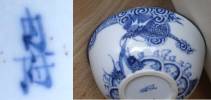
|
1276. Bowl. Mark reads Nei Fu, can be translated as "Inner Court". On Chinese "Bleu de Hue" porcelain, for the Vietnamese market. Mid 19th C. |

|
1277. Dish. Chinese "Bleu de Hue" porcelain, for the Vietnamese market. 18h century. |
| Bo Jia, Zhong Wangguo Jia Bo Shi - 中王國賈伯氏 | |
|---|---|
| Middle Kingdom, Modern porcelain factory in Jingdezhen founded by Bo Jia and Alison Alten in 1998 near the old imperial kilns in Jingdezhen. Specializing in modern interpretations of classical designs and glazes. Use electrical turning wheels and gas heated kilns for better control. All pieces correctly marked and signed. | |
 |
1592. Mark: Bo Jia, Zhong Wangguo Jia Bo Shi. Contemporary art porcelain, designed by Bo Jia. |
| Brown etched marks (Continue to section ->) | |
|---|---|
 |
307. Chenghua Nian Zhi (Chenghua Period Make). Late 20th century, post "Cultural Revolution". |
| "CHINA" | |
|---|---|
| The traditional wisdom has it that between around 1890 until c. 1920 all Chinese items that were to be imported into the US was required to be marked with the word "CHINA" as the country of origin (U.S. Stamp Act of 1894). Quite some uncomplicated research i. e. searching on the Internet confirms that this was not entirely true. Some were marked and some not. It is also far from certain that the practice of marking porcelain with the word CHINA actually ended in the 1920. Some porcelain I have found in Singapore marked in such way, the dealers have been very adamant that it dated to the 1970s. From 1919 the word "CHINA" should have been replaced by the phrase "Made in China" but despite this the single word "CHINA" occurred on pieces made well in to the 1960 and 1970s especially if other markets than North America are considered. | |
 |
279. Probably c. 1910-20. |
 |
2. Probably 1920-1930s. |
 |
296. Probably c. 1910-30. |



|
66, 197, 199. Mid 20th century, c. 1950-60. |

|
205. Mid to late 20th century, c. 1960 or later. |
 |
514. Probably c. 1930-60. |
 |
509. Probably c. 1960-70. |
 |
600. Probably c. 1960-70. |
 |
637. Mistake "CHINA" mark, either genuine and then from the Guangxu /Early Republic period, or a "mock mistake" and then new. My guess c. 1930. |
| Chun Lung Sang, Hong Kong decorated | |
|---|---|
| "Chun Lung Sang was a large shop in Central Hong Kong, at Queen Victoria Street just opposite the Central Market. That was the main shop. There were other shops in Kowloon and New Territory. It was first owned by Mr. Li, who had been around longer than anyone could remember. In 1964 Mr. Li sold his business then located in Shan Wan, to Mr. Fung, Mr. Young, Mr. Wong and Mr. Kung (owner of the Wa Lee Co.). It was then moved to Central, and ran there from 1965 to 1995." | |

|
376. Mark: Chun Lung Sang, Ci Yi You Xian Gong Ci, Tel 436140, Chun Lung Sang Porcelain Company Ltd.
With 'lead warning' label. In 1997 a HK Concumer Council Report was released about that some decorative porcelain with heavy lead content may damage health. Labels like this seems to have been added from that time. Compare also mark # 309 |
 |
436. Mark: Chun Lung Sang. Possibly porcelain made in Japan, with thin, light, shallow foot rim. Entirely different from most HK decorated pieces.
Decorated in Hong Kong and in person dated by porcelain merchant Mr. Kung, Hong Kong, to the 1960s, while visiting his shop in 2001. Dish "A" |
| Guangdong Gong Yi - Canton Art | |
|---|---|

|
119. Guangdong Gong Yi (Canton Art) on bowl with Rose Mandarin decoration, supplemented with sticker saying "decorated in Macau". Mid 20th century. The sticker might have been applied for the purpose of avoiding tax, since it actually are a sticker and not stamp, and the whole thing might be from Canton anyway. |
| Guangxu Nian Zao (1875-1908) | |
|---|---|
 |
408. Guangxu Nian Zao Export quality, genuine mark and of the period, dated 1887. Qiangjing enamels, text on the sides reads "Painted by Li Yan Qing in 1887".
|
 |
285. Guangxu Nian Zao Export quality, genuine mark and of the period, probably last decades of the 19th century. |
 |
285. Guangxu Nian Zao - (1875-1908). Export quality, genuine mark and of the period, probably last decades of the 19th century. |
 
|
194, 209. Stamped mark: Da Qing Guangxu Nian Zhi - "Guangxu period (1875-1908) made" with "CHINA" export mark. 20th century. |
 |
585. Mark: Da Qing Guangxu Nian Zhi - "Guangxu period (1875-1908) made". Second quarter of the 20th century. |

|
630. Dated in the inscription Republic 23rd year March Lin Dong made in Nanchong Mark: Da Qing Guangxu Nian Zhi - "Guangxu period (1875-1908) made" but dated in the inscription to 1934. |

|
381. Mark: Da Qing Guangxu Nian Zhi - "Guangxu period (1875-1908) made". Late 20th century? |

|
763. Guang Xu Qing Yu Tang Cang "From the Guangxu Collection of the Hall for Celebrating Surplus" or "hall of celebrating bounteous harvest". Date uncertain. |

|
1322. Footed bowl. Mark: Da Qing Guangxu Nian Zhi (1875-1908). Peoples ware. Iron red stamped seal script mark. Probably Guangxu period. |

|
1364. Dish. Mark: Da Qing Guangxu Nian Zhi (1875-1908). Peoples ware. Iron red stamped seal script mark. Probably Guangxu period. |

|
1415. Small vase w elephant handles. Mark: Iron red stamped seal mark Guangxu Nian Zhi (1875-1908). Decoration signed by Xu Pinheng. On the opposite side a verse. Date c. 1895. |
| Hall's / Buyer's names | |
|---|---|

|
562. Shi Jin Tang Zhi ,-"Shi" means generations, "Jin" means glory, forever glories? Probably early Republic, c. 1910-30. |

|
288. Xushenfang Zhi "Xu Shen Estate Ordered / made to order by Xu Shen House". Probably early Republic, c. 1920. |

|
440. Plate says: Ru Yi Ji Xiang , common greetings. Mark says : Gui Fang Chun Guan where Gui - (gather) Fang - (fragrant) could be a girl's name, Chun is spring, young, tender, joy and Guan is an inn or a lodge. Tentative translations "Gui Fang's maiden lodge" or "The Spring Month of Gathered Scents". Tentatively Daoguang (1821-1850) period. |

|
291. "Guyue Xuan", Mark on Chinese Snuff Bottle, Glass, 20th century.
Since this is a modern piece the details on the "Guyue Xuan" will be dealt with at some other time and place. To summarize "Guyue Xuan" might be a Qing Court room, but no evidence has been established. Some have it, it was made by a master potter of the Qing Court named "Wu", as "Gu Yue" put together becomes "Wu", which is a common surname. Some are satisfied by "Guyue Xuan" as a referral to a particular enamels decoration. |

|
292. Mark: Da Xiong Bao Dian. "The hall of great elegance" Litt.: "Great Mighty Holy Temple". Mid to late 20th century date.
Buddhist temples are made up of several buildings, of which any central temple would have this name displayed right across at the top center. See also # 305. |

|
286. Mark: Yi Xiang Yuan Joy Beauty Garden / Paradise of Joy and Beauty. Mark on Chinese porcelain erotic cup. 1970 or later. |

|
284. Transformed style of seal mark, hard to make out the meaning but, could be "Hall of Hundred Tortoises". It is 20th century and could quite possibly be a Japanese mark imitating a Chinese. The cut off corners of the double framed seal is a significant feature which the painter seems to be unaware of. |

|
323. Re Shen Zhen Cang,-"Re Shen (name) Precious Treasure". This mark is found on a large group of blue & white porcelain. The mark first appeared in the Kangxi period and became popular in the Late Qing to the Early Republic period (1900-1950). Widely used in modern replicas. |
| Hong Kong, Decorated in (written in Western characters) | |
|---|---|
| Since adding enameled decoration on white porcelain is a small scale business that could be set up anywhere with very little capital, porcelain decorators probably moved from Canton to Hong Kong to set up shop there immediately by the time of its founding in the 19th century.
The Hong Kong porcelain trade hit its peak in the 1960s, with just over a hundred workshops in the Territory only. At this time the demand for Hong Kong decorated porcelain forced the workshops to also import white porcelain from Japan to be decorated in Hong Kong. Some trading agents specifically ordered plain porcelain from Japan. The quality and price appears to have been the same as the Chinese. |
|

|
368. Stanley, Hand Decorated in Hong Kong. Mid 20th century. |

|
56. W.S.L. DECORATED IN HONG KONG |

|
179. "Decorated in Hong Kong", mark on modern porcelain spoon |

|
272. "Decorated in Hong Kong", mark on porcelain dish dated by Mr. Kung, porcelain merchant in Hong Kong, to 1960. Two dishes and marks # 272 and # 273 |

|
1511. "Decorated in Hong Kong", mark on porcelain dish and lotus shaped cup. Tentatively 1960-80s. |

|
143. W.B.I. MADE IN CHINA. Appears to be a Canton or Hong Kong enameled vase. Early to mid 20th century. |

|
146. "Y.T. Decorated in Hong Kong". Modern "Rose Medallion" plate. Late 20th century. |

|
924. Mark: "Y.T. Decorated in Hong Kong". Modern "Rose Medallion" plate. Late 20th century. |

|
262. Mark: Hong Kong Wing Suen Lung Added Enamels. "Wing Suen Lung Factory" was owned by Mr Seto in Sai Wan Ho, East part of HK island in the 1950s. Mr. Seto ceased the business and immigrated to Canada in 1965. Date c. 1960. |

|
712. Mark: "AFC-Decorated in Hong Kong", Date: Fourth quarter of 20th century. |

|
1395. Dish. Printed mark in good quality: ACF, Japanese Porcelain Ware, Decorated in Hong Kong. Date: Most likely around 1970. |

|
1460. Dish. Printed mark in good quality: ACF, Japanese Porcelain Ware, Decorated in Hong Kong. Date: Most likely around 1970. |
| Hong Kong, Made in | |
|---|---|

|
1288. "Made in Hong Kong" According to family history this was ordered from China in the early 1950s. |
| Hongxian Nian Zhi (1916) | |
|---|---|
| This mark should if correct, date to the year 1916 when Yuan Shikai made himself the Emperor of China after the Qing Dynasty was overthrown by Dr. Sun Yat-Sen in 1911. His Empire was soon ended in March 1916 and his period lasted less than 100 days. The 20 November 1915 Yuan held a political convention which endorsed monarchy. By 12 December, he proclaimed his reign as Emperor of the Chinese Empire under the era name of Hongxian i.e. "Constitutional Abundance" to begin on 1 January 1916. Due to massive opposition funding for the ceremony was cut on March 1st and he abandoned monarchism on March 22 after which he eventually died, humiliated, on the 5th of June. It is my opinion, that none of these marks actually dates to the Hongxian period but probably not earlier than the 1930s. | |

|
100. Hongxian Nian Zhi (Hongxian Period Make). The mark probably from the 1930s |
| Hua Ping Tang Zhi - 华平堂制 - Hua Ping Hall Make | |
|---|---|
| Later Chinese porcelain with thinly applied enamels. Similar to the WL1895, being the mark of the Hong Kong manufacturer United Wilson. All pieces with marks of this kind appears to date to the last quarter of the 20th century. | |

|
769. Mark: Hua Ping Tang Zhi - Hua "China", "Magnificent", Ping "even", "level", "democratic" or a surname, Tang "Hall", Zhi made. Submitted picture very small but if the enamels are very thin the decoration is probably printed and the tureen should date to 1975-2000. |
| Jiangxi Ciye Gongsi | |
|---|---|
| "Jiangxi Ciye Gongsi" (Jiangxi Porcelain company) was the largest porcelain factory in Jingdezhen during the first half of the 20th century and in general felt being the organization that replaced and absorbed much of the talent and resources from the Imperial porcelain factory when it fell in abandonment after the fall of the Qing dynasty. It was established in 1910 and eventually nationalized and its name changed to Jianguo Cichang in 1949. | |

|
169. Jiangxi Ciye Gongsi (Jiangxi Porcelain company). The most important factory in Jingdezhen. Established in 1910, nationalized and its name changed to Jianguo Cichang in 1949. This mark probably somehow related to #158. |

|
308. Jiangxi Ciye Gongsi (Jiangxi Porcelain company). Early to mid 20th C ? |
| Jiangxi Jingdezhen Chu Pin (Jiangxi Jingdezhen Production) | |
|---|---|

|
216. Mark: Jiangxi Jingdezhen Chu Pin (Jiangxi Jingdezhen Production) |
| Jiangxi Jingdezhen Min Ci # - (Jiangxi Jingdezhen Reputable Porcelain Factory #)
MORE >> |
|
|---|---|

|
213. Jiangxi Jingdezhen Min Ci (Jiangxi Jingdezhen Reputable Porcelain). Factory # 1. |
| Jiangxi Jingdezhen Min Ci # Hao Cai - (Jiangxi Jingdezhen Reputable Porcelain # enamel pattern) | |
|---|---|
 
|
438 1,b. Jiangxi Jingdezhen Min Ci 3 Hao Cai - "Jiangxi Jingdezhen Reputable Porcelain # 2 Enamel Pattern" and same, Pattern # 3. Strangely enough the "pattern #" are different but the bowls are identical. Early Peoples Republic period (1949-1966), probably 1960s. |

|
211. Mark: Jiangxi Jingdezhen Min Ci 3 Hao Cai (Jiangxi Jingdezhen Reputable Porcelain No.6 enamel pattern). Early Peoples Republic period (1949-1966), probably 1960s. |

|
162. Mark: Jiangxi Jingdezhen Min Ci 6 Hao Cai (Jiangxi Jingdezhen Reputable Porcelain No.6 enamel pattern). Early Peoples Republic period (1949-1966), probably 1960s. |
 |
337. Mark: Jiangxi Jingdezhen Min Ci 8 Hao Cai (Jiangxi Jingdezhen Reputable Porcelain No.8 enamel pattern). Early Peoples Republic period (1949-1966), probably 1960s. |
| Jiangxi Zhen Pin - (Jiangxi Precious Product) | |
|---|---|

|
1589. Tea set, gold and enamels. Mark Jiangxi Zhen Pin, Jiangxi province precious product. Tentative date last quarter of the 20th century. |
| Jingdezhen Ci Ye Gong Si Chu Pin (Jingdezhen Porcelain Company Production) | |
|---|---|

|
158. Mark: Jingdezhen Ci Ye Gong Si Chu Pin - Jingdezhen Porcelain Company Production. Mark probably somehow related to # 169. |
| Jurentang | |
|---|---|
| Research indicates that "Juren Tang" in Zhongnanhai was the building where Yuan Shikai lived and where he had his office around 1915. Guo Baochang, an antique dealer with a good relation to the court, was appointed to arrange for imperial Hongxian wares being made in 1916. What really came out of this is still debated. One opinion is that no pieces bearing the Hongxian mark is of the period, the only possibly genuine mark of the period being "Jurentang", if any. | |
 |
418. "Jurentang" mark. Republic period. Family tradition has it that this vase "was originally made for an imperial or high level government official". The vase could be traced back in the family to mid 1920s-mid 1940s. |
 |
328. "Jurentang" 1980 or later. |
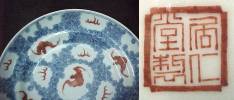 |
329. "Jurentang" mark 1960 or later. Interestingly enough the front page of the plate seems to be from 1900-1920 while the foot rim and the flowers scrolls on the back side of the dish gives it away as 1960s or later too. |
| Kangxi (For genuine marks of the period, see Qing dynasty page) | |
|---|---|
|
Kangxi marks are by far the richest group compared to all other period marks. Many also consider Kangxi porcelain the peak of Chinese porcelain and some Kangxi fakes are the most difficult of all to tell. Genuine marks from the period: During most of the Kangxi reign the emperor's mark was not allowed to be used, so other symbols, or frequently the nian hao of the Ming emperor Chenghua's period took its place. There could also be used just two empty circles with no mark within, or even no mark at all, or 4 character hallmarks or other symbols or marks of commendation. Late in the period the order was rescinded and a 6-character reign mark was permitted. The only time a Kangxi Imperial mark appeared without the circles was on the peach bloom wares and certain other scholar's table items and it is (almost) always 6 characters, written either in two horizontal lines or two vertical columns. Some Imperial pieces decorated at the Palace Workshops that were made late in the reign had a four character reign mark, but they are always enclosed by a double square and are almost always written in over glaze blue enamel. Copies and later marks: As a general rule, all four character Kangxi Nian Zhi marks written inside double circles or without circles are from the end of the 19th century or later. Items made in the manner of or style of Kangxi in the 19th C many times do have four character reign marks. This makes it easy to tell at a glance in most cases whether the piece is really from the Kangxi period or not. Some of these pieces are very close in style to the originals but if you compare them to genuine Kangxi wares the paste, glaze, footrim and the blue is different. Crude attempts to mimic Imperial marks are sometimes found on minyao wares but generally this is not the case on export wares, as most bear no marks. Red four character Kangxi Nian Zhi marks within a square becomes particularly popular during the 1970s. |
|
 |
572. Kangxi Nian Zhi -"Kangxi Period Make". C. 1900-1910. |

|
401. Kangxi Nian Zuo - "Kangxi Period Make". Early 20th Century. |
 |
336. Kangxi Nian Zhi - "Kangxi Period Make", c. 1920. |

|
797. Kangxi Nian Zhi - "Kangxi Period Make". Early 20th century, c 1920 |

|
675. Mark: Kangxi Nian Zhi - "Kangxi Period Make" but c. 1880. |

|
732. Mark: Kangxi Nian Zhi - "Kangxi Period Make" but c. 1900. |
 |
676. Mark: Kangxi Nian Zhi - "Kangxi Period Make" but from the Guangxu period, c. 1890. |

|
90. Kangxi Nian Zhi - "Kangxi Period Make" |
 |
332. Kangxi Nian Zhi - "Kangxi Period Make", 1960s. Decorated in Hong Kong. Date by Mr. Kung, porcelain merchant in Hong Kong. |
 |
273. Kangxi Nian Zhi - "Kangxi Period Make", c. 1960. Decorated in Hong Kong. Date by Mr. Kung, porcelain merchant in Hong Kong.
|
 |
259. Kangxi Nian Zhi - "Kangxi Period Make", c. 1970. Decorated in Hong Kong. Date by Mr. Kung, porcelain merchant in Hong Kong. |
 |
331. Kangxi Nian Zhi - "Kangxi Period Make", 1960s. This dish is decorated in Hong Kong and the date suggested by Mr. Kung, porcelain merchant in Hong Kong. The line "ABRIGADO EM MACAO" (Greetings From Macau) mark could be a tax or export consideration. |
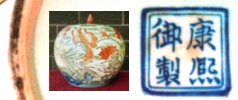 |
412. Lidded Jar. Kangxi Yu Zhi - "Made to the order of the Emperor Kangxi". Late 20th century. |
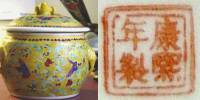 |
695. Kangxi Nian Zhi - "Kangxi Period Make", probably c. 1960s |

|
571. Mark: Da Qing Kangxi Nian Zhi - "Great Qing dynasty Kangxi Period Make". 20th century. |
 |
816. Mark: Da Qing Kangxi Nian Zhi - "Great Qing dynasty Kangxi Period Make". Probably 1890-1910 |
 |
780. Mark: Da Qing Kangxi Nian Zhi - "Great Qing dynasty Kangxi Period Make". Mark with typical "hollow line". Date probably first decades of the 20th century, 1900-1930. |
 |
1235. Mark: Da Qing Kangxi Nian Zhi - "Great Qing dynasty Kangxi Period Make". Probably after Cultural Revolution, second half 20th century. |

|
322. Kangxi Nian Zhi - "Kangxi Period Make". Mid 19th century to possibly early 20th century. |

|
1221. Tea canister, mark: Kangxi Nian Zhi - "Kangxi Period Make". Date: Mid 20th century. |

|
1376. Ginger jar with traditional "prunus/plum blossom" decoration. Mark: Kangxi Nian Zhi - "Kangxi Period Make". Date: Mid 20th century before 1975, and then probably also before the Cultural Revolution (1965-75). |
| "Made in China" | |
|---|---|
| From 1919 "CHINA" was to be replaced by "Made in China" on all Chinese export to the US. Even if "CHINA" continued to be used for a long time, we can still assume that no marks with the full text "Made in China" is from before 1919 and more likely to be from the second WW or later. | |
 |
1465. Mid 20th century 1930s to 1960s. |
 |
494. Late 20th century. Tentative date 1980s. |
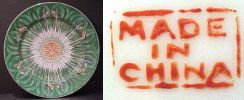
|
290. Mid 20th century, probably 1960s. |

|
631. Dated in the inscription to 1936. Mark: Made in China |
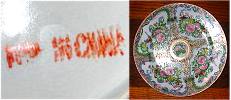
|
1105. Mark: Made in China, tentative date 1930s, possible slightly before WWII. |

|
560. Mark: Hand-painted decoration, Made in China. Probably 1960s. |

|
442. Mark: Hand painted Made in China , Mid 20 century, probably 1960s or later. |
 |
3. Mark: Qianlong Nian Zhi - "Qianlong Period Make". Export seal mark. "MADE IN CHINA". In the smudged area between "MA(DE IN) CHINA" and the seal mark, there seems to be the beginning of "Zhongguo (.. Jingdezhen China?)" which would indicate a date from the 1950s until present. Mid 20th century. |
 |
1547. Mark: Made in China, under Zhongguo Zhi Zao, meaning the same. Tentative date last few decades of the 20th century. Decoration is Rose Medallion Butterfly export pattern. |

|
168. Mark: Qianlong Nian Zhi - "Qianlong Period Make". (Da Qing omitted) Tentative date: Early Peoples Republic period (1949-1966), probably 1950s. |
| Ming - Marks including the character or a period, but from Qing or later | |
|---|---|
| All marks in this section are somehow referring to the Ming dynasty. They are with no exceptions from after the Ming dynasty and up until today in some cases. Real MING marks that actually are of the period, plus a type chart, is available here >> |
|

|
107. Mark: Da Ming Chenghua Nian Zhi (Great Ming Chenghua Period Make). Late 19th century, probably around 1860s. |
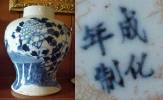
|
673. Mark: Chenghua Nian Zhi (Chenghua Period Make). Probably Guangxu (1875-1908) period. |

|
275. Mark: Chenghua Nian Zhi (Chenghua Period Make). Probably second half of 19th century, "Kangxi revival" period. |
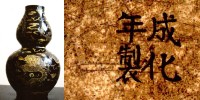 |
532. Mark: Chenghua Nian Zhi, Before 1910, probably Guangxu period (1875-1908) |

|
396. Mark: Xuande Nian Zhi (Xuande Period Make). Second quarter 20th Century. |
 |
301. Mark: Da Ming Chenghua Nian Zhi - "Ming Dynasty Chenghua Period Make". This is possibly from the 1990s. After Simon Kwan's exhibition of 20th century high quality porcelain even late pieces were imitated and this might be one of them. |
 |
1349. Mark: Da Ming Chenghua Nian Zhi - "Ming Dynasty Chenghua Period Make". Mark appears to actually be printed, date probably contemporary. |
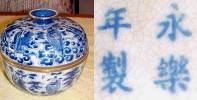
|
625. Mark: Yongle Nian Zhi - (Yongle Period Make), but modern-c. 1990s. The bowl possibly made in Thailand. |

|
773. Mark: Yongle Nian Zhi - (Yongle Period Make), but modern-c. 1990s. The bowl possibly made in Thailand. |

|
383. Mark: Yong Le Nian Zhi - (Yongle Period Make). |

|
265. Mark: Yongle Nian Zhi (Yongle Period Make) Mid 20th Century. (The bowl surprisingly comfortable to drink tea out of.) |
 |
300. Mark: Da Ming Chenghua Nian Zhi. Probably last quarter of 20th century. |
 |
491. Mark: Da Ming Chenghua Nian Zhi but probably 1990s. |
 |
492. Mark: Da Ming Nian Zhu - Great Ming Period Make. Modern ? |
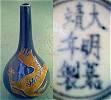 |
496. Mark: Da Ming Jiajing Nian Zhu - "Great Ming Jiajing (1522-1566) Period Make". Modern. |
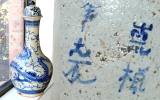
|
372. Mark: Chongzhen Nian Zhi, "Chongzhen (1628-44) Period Make". The mark appears as written by somebody who do not know Chinese even if the "Nian" character is good. Uncertain date. |
| Nanjing Road (Shanghai) | |
|---|---|

|
208. Mark: "Nanjing Road", famous business street in Shanghai, was at the height of its glory 1928-1938. |
| QING DYNASTY | |
|---|---|
| The best way to organize Qing dynasty seems for now to be by style. Seal marks are in the style of a seal and not difficult to tell. Song marks are in a hand written form and in Song's style of writing, then there is Ming, Qing, Republic, modern and after Cultural Revolution style of writings etc, this is a most specialized and difficult subject, and no books has as far as we know dared to touch on this yet, but being a true Viking I'll go about doing this soon, with the help of my Chinese speaking friends, who often can read even the most obscure renderings. |
| Qianlong Nian Zhi - Qianlong Period Make | |
|---|---|
| Qianlong or "Lasting Eminence" is the name of the reigning period (1736-1795) of the Chinese Emperor whose name was actually Hongli.
The reign mark "nian hao" of this period has been drawn on porcelain ever since, up until today. Later porcelain with this mark are often called "fakes" however the occurrence of this mark on later porcelain is most of the time seen as part of the decoration and not to be taken serious. This practise of applying stamped four character "Qianlong Nian Zhi" marks was especially common on porcelain decorated in Hong Kong during the 1960s and 70s, but is in no way limited to this period. In the following mark the two characters that gives the name of the dynasty Da Qing (Great Qing) is omitted, which is a common feature of marks that is not of the actual period. The following marks are in zhuanshu (archaic seal script) which technically speaking is a drawing and not 'hand-writing'. None of the following marks are of the Qianlong period despite that they say so. See comments next to each individual mark for an approximate date. | |

|
193. Mark: Qianlong Nian Zhi - "Qianlong Period Make". Stamped seal mark. Mid 20th century |

|
339. Mark: Qianlong Nian Zhi, "Qianlong Period Make". Modern mark, after 1960. |
 |
420. Mark: Qianlong Nian Zhi - "Qianlong Period Make". Early to mid 20th century. |
 |
521. Mark: Qianlong Nian Zhi - "Qianlong (1736-1795) Period Make". Seemingly authentic Straits Chinese market porcelain. |

|
254. Mark: Qianlong Nian Zhi - Ca. 1990-95. |

|
248. Mark: Qianlong Nian Zhi - "Qianlong Period Make". |
 |
1497. Mark: Qianlong Nian Zhi - "Qianlong (1736-1795) Period Make". Extremely fragile Jingdezhen eggshell ware from around 1990. Outlines of the decoration are stamped and manually filled in with colored enamels. Usually young women was doing this kind of work. Each bowl did not take many seconds to decorate. Price after negotiations directly at the night market in Jingdezhen was about 5 yuan each, (c:a US $ 0.50). The drawback was that they were nigh impossible to transport due to their fragility. Being the thickness of lamp bulb glass the temptation was irresistible to stack them 20 at a time in oblong boxes intended for vases, upon which they arrived as that much porcelain confetti. Only way, was to give them one box each which of course added to the cost. (JEN 1991) |
| Following marks are in Kaishu (normal script) style. This is the present-day regular script, which has been in existence now for almost 2000 years. As opposed to seal script, which is drawing, this is hand writing. None of the following marks are of the Qianlong period despite that they say so. See comments next to each individual mark for an approximate date. | |

|
1394. Mark: Qianlong yuzhi - "Qianlong Period, Made", tentative date Early Republic, c. 1930 |

|
260. Mark: Qianlong Nian Zhi - "Qianlong Period, Made", 1970. Decorated in Hong Kong. Date by Mr. Kung, porcelain merchant in Hong Kong. |
 |
335. Qianlong Nian Zhi - "Qianlong Period (1736-1795) Make". From the 'realistic' look of the decoration despite the small scale of the available picture, I would like to suggest a date to around 1950s on this piece. |

|
1089. Mark: Qianlong Nian Zhi - "Qianlong Period (1736-1795) Make", early second half of 20th century. The crisp and slightly 'naïf' style of the decoration is charateristic of the period immediately before the cultural revolution. |

|
1377. Mark: Qianlong Nian Zhi - "Qianlong Period (1736-1795) Make". The crisp and slightly 'naïf' style of the decoration is characteristic of the period before the cultural revolution that started in 1965. The use of black and orange rust colored enamels is very typical of the very last years of the 1940s. Date: Mid 20th century.
. |

|
414. Mark: Qianlong Nian Zhi - Qianlong Period Make. Due to the shaky lines in the decoration I would like to suggest a date on this vase to around the 1970s or later. |
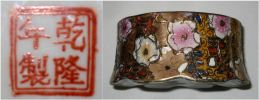
|
1372. Mark: Qianlong Nian Zhi - Qianlong Period Make. Japanese moriage decoration imitation. Suggested date; 1990s or later. |

|
1073. Mark: Qianlong Nian Zhi - Qianlong Period Make. Second half of 20th century. Due to the shaky lines in the decoration I would even like to suggest a date on this vase to around the 1970s or later. |

|
1518. Qianlong Nian Zhi - "Qianlong Period Make". Seal mark in raised blue enamels. 20th century, tentative date mid 1940s. |

|
311. Mark: Qianlong Nian Zhi - C. 1990-95. |

|
253. Mark: Qianlong Nian Zhi - c. 1990-95. |

|
304. Mark: Qianlong Nian Zhi - "Qianlong Period Make". Stamped export seal mark with "MADE IN CHINA". The "poisonious glaze" warning label seems to indicate a date after 1970. |
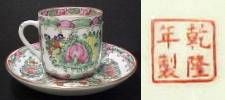
|
315. "Qianlong Nian Zhi", Close resemblance to mark # 314, enamels added in Hong Kong 1960 by Wa Lee Company. |
 |
316. Mark: Qianlong Nian Zhi. Enamels added in Hong Kong, 1960 by Wa Lee Company. |
 |
320. Mark: Qianlong Nian Zhi. Enamels added in Hong Kong, 1960 by Wa Lee Company. |
 |
318. Mark: Qianlong Nian Zhi. Enamels added in Hong Kong, 1960 by Wa Lee Company. |

|
422. Mark: Qianlong Nian Zhi - "Qianlong Period Make". |

|
255. Mark: Qianlong Nian Zhi - "Qianlong Period Make". |

|
198. Mark: Qianlong Nian Zhi - "Qianlong Period Make". |

|
132. Mark: Qianlong Nian Zhi - "Qianlong Period Make".Qianlong Nian Zhi - "Qianlong Period Make". Probably early 20th century. |

|
87. Mark: Qianlong Nian Zhi - "Qianlong Period Make". The special calligraphy of this mark should be compared to # 134, 115 and 263. For the time being I would like to suggest that this mark is a Hong Kong mark from the 1960s. |

|
397. Qianlong Nian Zhi "Qianlong Period Make". Mid 20th Century. |

|
405. Mark: Qianlong Nian Zhi - "Qianlong Period Make". Late 20th century. |


|
1482. Bowl and 1481. Spoon. Mark: Qianlong Nian Zhi - "Qianlong Period Make". According to family documents this set was taken out of China just prior to 1949. Good quality decoration with hand drawn outlines and decoration in opaque famille rose enamels. The inside of the bowl is plain white exactly the same as the bottom of the spoon (a very few flecks of brown). Tentative date are the 1940s, not later than 1949. |
| Qianlong Nian Zhi, Da Qing - Qianlong Period Make, Great Qing Dynasty | |
|---|---|
| These six character marks follow the traditional way of drawing seal marks in archaic seal script, zhuanshu, from the Qianlong period 1736-1795. The manner is a drawing more like an engraving rather than actual hand writing. None of the following marks are of the Qianlong period despite that they say so. See comments next to each individual mark for an approximate date. | |

|
261. Mark: Da Qing Qianlong Nian Zhi - "Great Qing Dynasty, Qianlong Period, Made", 1970. Decorated in Hong Kong. Date by Mr. Kung, porcelain merchant in Hong Kong. |

|
340. "Qianlong Nian Zhi" "Qianlong Period Make". Modern mark, after 1960. |

|
247. Da Qing Qianlong Nian Zhi "Great Qing Qianlong Period Make". Tentative period 1950-75. |

|
419. Mark: Da Qing Qianlong Nian Zhi, "Great Qing Qianlong Period Make". Mid 20th Century. Marks with this wide frame is likely to be from after the 1960s and should be compared to the Macau style marks. |
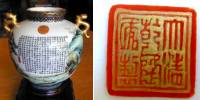 |
602. Mark: Da Qing Qianlong Nian Zhi Date 1940s before 1949. Cf., HA van Oort, pp. 165-167. |
 |
373. Mark: Da Qing Qianlong Nian Zhi - "Great Qing Qianlong Period Make". Porcelain with this "hard" color scheme seems to be contemporary with the influence from Russia in the 1950s. Note the black top rim ruyi border, cf. #261 (1970) and #501 (1966-76). Early Peoples Republic period (1949-1966). |

|
65. Mark: Da Qing Qianlong Nian Zhi- Blue and white chinese export porcelain replica/emulation. Note the crackled glaze. Late 20th/early 21th century. |
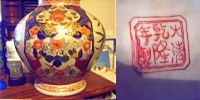
|
1030. Mark: Da Qing Qianlong Nian Zhi-(Chinese emperor Qianlong period make) but unfortunately not of the period. It is a Chinese new decorative ware not older than the 1970s. |

|
85. Da Qing Qianlong Nian Zhi "Great Qing Qianlong Period Make". Probably 20th century. |

|
339. "Qianlong Nian Zhi" "Qianlong Period Make". Modern mark, after 1960. |

|
340. "Qianlong Nian Zhi" "Qianlong Period Make". Modern mark, after 1960. |
 |
1488. Mark: Da Qing Qianlong Nian Zhi - "Great Qing Dynasty, Qianlong Period, Made", Mark stamped with double outlines. Tentative date Guangxu period 1875-1908. |
 |
317. Mark: Da Qing Qianlong Nian Zhi - "Great Qing Dynasty, Qianlong Period, Made", 1960. Decorated in Hong Kong. Date by Mr. Kung, porcelain merchant in Hong Kong. |

|
168. Mark: Qianlong Nian Zhi - "Qianlong Period Make". (Da Qing omitted) Tentative date: Early Peoples Republic period (1949-1966), probably 1950s. |

|
733. Mark: Da Qing Qianlong Nian Zhi - "Great Qing Qianlong Period Make". Tentative date: 1960s. period. |
 |
317. Mark: Da Qing Qianlong Nian Zhi - "Great Qing Dynasty, Qianlong Period, Made", 1960. Decorated in Hong Kong. Date by Mr. Kung, porcelain merchant in Hong Kong. |
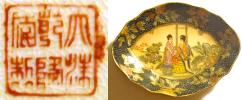
|
1410. Mark: Da Qing Qianlong Nian Zhi - "Great Qing Dynasty, Qianlong Period, Made". Possibly decorated in Hong Kong, around 1960-90. |
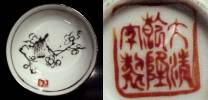
|
313. Mark: Da Qing Qianlong Nian Zhi - "Great Qing Dynasty, Qianlong Period, Made" Information gained by Mr. Kung, porcelain merchant in Hong Kong, this is decorated in Hong Kong around 1960. |

|
1078. Mark: Da Qing Qianlong Nian Zhi - "Great Qing Dynasty, Qianlong Period, Made" Probably decorated in Hong Kong around 1960. |

|
77. Da Qing Qianlong Nian Zhi "Great Qing Qianlong Period Make". Gu Gong Fu Zhi (Palace Museum Replica Producation), Before 1990. |

|
172. Da Qing Qianlong Nian Zhi "Great Qing Qianlong Period Make". Mid 20th century or later. |

|
281. Da Qing Qianlong Nian Zhi "Great Qing Qianlong Period Make". Plate probably from the 1930-40s period. |
 |
413. Mark: Da Qing Qianlong Nian Zhi- "Great Qing Qianlong Period Make". |
 |
297. Mark: Da Qing Qianlong Nian Zhi- "Great Qing Qianlong Period Make". Probably 3rd quarter of 20th century. |
| Kaishu - (normal script) style. As opposed to seal script, which is drawing, this is hand writing | |

|
733. Mark: Da Qing Qianlong Nian Zhi - "Great Qing Qianlong Period Make". Tentative date: 1960s. period. |

|
282. Mark: Da Qing Qianlong Nian Zhi. Meaning: "Great Qing Qianlong Period Make". Black gilded lidded jar, tentative date 1950s-60s |

|
184. Mark: Da Qing Qianlong Nian Zhi. Meaning: "Great Qing Qianlong Period Make". Modern Chinese porcelain spoon. Date: Late 1960s to c. 1990. |

|
513. Mark: Da Qing Qianlong Nian Zhi. Meaning: "Great Qing Qianlong Period Make". Modern Chinese porcelain spoon. Date: Late 1960s to c. 1990. |

|
403. Mark: Da Qing Qianlong Nian Zhi, Meaning: "Great Qing Qianlong Period Make". Date: Late 1960s to c. 1990. |

|
377. Mark: Da Qing Qianlong Nian Zhi, Meaning: "Great Qing Qianlong Period Make". Date: Late 1960s to c. 1990. |

|
914. Mark: Da Qing Qianlong Nian Zhi, Meaning: "Great Qing Qianlong Period Make". Date: Late 1960s to c. 1990. |
| Shende Tang Zhi - (Made for The Hall of Prudent Virtue) | |
|---|---|
| The 'Shende Tang' (Hall of Prudent Virtue) referred to in the base mark was the residence of the Daoguang Emperor in the Yuanming Yuan summer palace in the outskirts of Beijing, where it was located at the western side of the Jiuzhou Qingyan (Palace of Peace in the Nine Regions). The Shende Tang was completed in 1831, thus making Daoguang pieces with this mark attributable to the two decades between 1831 and 1850; see Ming Wilson, Rare Marks on Chinese Ceramics, London, 1998, cat. no. 8, where a yellow-glazed bowl with cranes bearing this mark is illustrated, from the collection of the Victoria and Albert Museum, London. | |

|
126. Shende Tang Zhi - "Shende Tang Made", where "Zeng" is accumulating, collecting, learning, "De" is virtue, "Tang" is hall. |

|
144. Mark: Shende Tang Zhi - "Shende Hall Made". This could be translated as 'Made for the Hall of Prudent Virtue'. This mark first appeared in the Daoguang period and continued to be used until mid 20 th Century. This mark: Guangxu period (1875-1908) or a few decades into the 20th century. |
 |
299. Mark: Shende Tang Zhi - Shende Hall Made. This mark: Probably early to mid 20th century. |
| Taiwan | |
|---|---|

|
185. Mark: Da Tong Yao, Taiwan, (Da Tong Kiln, Taiwan). Mark on modern Chinese porcelain spoon. |
| Tang Shan Porcelain Factories, from 1920s | |
|---|---|
| Tang Shan is a city in Hebei province. In 1976 the Tang Shan earthquake wiped out the entire city. Tang Shan has produced porcelain of good quality but less known then it southern competitors Jingdezhen in Jiangxi province and the Liling kiln in Hunan but has produced grand pieces in similar styles. The 1965 Tangshan Ceramic book tell there were three major porcelain factories in Tangshan from 1920s. The Qi Xin Factory, first established in 1924 and changed name to Tangshan 5th factory around 1950s, sub-divided to Yue Feng Sub-division Factory in 1958. The second factory was the De Cheng factory and the third, the Xin Min factory.
Picture: Tang Shan De Cheng Factory, c. 1930 | |
 |
1325. Vase of eggshell thinness. Tangshan 4th Porcelain Factory, Yue Feng Sub-division, c. 1960. Mark reads from left to right, first line says 唐山西(Si (fourth))陶 (Tang Shan Si Tao), The forth character 陶 means pottery. The second line reads 裕丰分厂 (Yu Feng Fen Chang). 裕丰 is the name of the company and 分厂 basically means branch factory which gives us Yue Feng Sub-division Factory. |
 |
1326. Teapot. Mark: Min Gou Tang Shan Tangshan Bone China, Made In China, modern export porcelain, c 1960-90. |
 |
1327. Plate. Mark: Min Gou Tang Shan Tangshan Fine Bone China, Made In China, modern export porcelain, c 1960-80. |
 |
1328. Vase decorated in green monochrome glaze. Mark: unclear but probably Min Gou Tang Shan, date c. 1960-80. |
| Tongzhi Nian Zhi-Tongzhi Period [1862-74] Make | |
|---|---|
| For all practical purposes I have decided to think of all hand written Tongzhi marks as of the Tongzhi period and those who are stamped, as later and with few exceptions of the later Guangxu period (1875-1908). So far this seems to make sense with the certain exception of marks from the Cultural Revolution period, when Tongzhi marks enjoyed an unexplained popularity on items decorated in Macau or Hong Kong. One complicating matter is also that some seal marks that looks stamped could well be hand drawn or, stamped and then manually touched up. In those cases I think we can assume that the piece is of the period. | |

|
287. Tongzhi Nian Zhi - "Tongzhi (1862-74) Period Make". Handwritten and probably of the period. Unfortunately we don't have a picture of the piece. |
 |
1323. Teapot with sepia decoration from Journey to the West. Mark: Tongzhi Nian Zhi - "Tongzhi Period Make". Mark most carefully hand drawn to look like a neat seal. Possibly of the period. |
 |
298. Tongzhi Nian Zhi - "Tongzhi (1862-74) Period Make". Stamped mark, probably Guangxu period or slightly thereafter. |
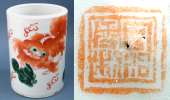 |
754. Mark: Tongzhi Nian Zhi - "Tongzhi Period Make". Stamped mark, dating to after the Guangxu period comfirmed by date in the inscription "made by Cheung Wen-tai in the winter of 1909", inscription meant to congratulate people on a bright and promising career etc.
|
 |
489. Bowl. Mark: Tongzhi Nian Zhi - "Tongzhi (1862-74) Period Make". Probably Guangxu period or later |
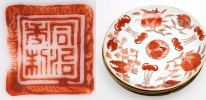 |
1552. Dishes. Stamped Mark: Tongzhi Nian Zhi - "Tongzhi (1862-74) Period Make". Probably Guangxu period 1875-1908. The frame around the mark appears unusually wide but since both the characters and the dishes themselves appears to be correct, I don't think there is any reason to doubt the mark as being correct. |

|
269. Tongzhi Nian Zhi-"Tongzhi Period Make". This mark is probably not antique. The date is uncertain and no picture of the piece is available for help. The mark is similar to mark #107 but the general looks seems to suggest Macau decorated porcelain from third quarter of the 20th century. |
| Wanyu | |
|---|---|
| Wanyu appears on Chinese porcelain from the Kangxi period and onwards. The mark shows the characters for (top) plaything/to play and (bottom) jade. The meaning is rather abstract but can perhaps be translated as "jade trinket" or "antique porcelain as fine as jade". The mark first appeared in Kangxi but has been used well into the 20th century. It is also one of the marks used on later Bleu de Hue porcelain for the Vietnamese market | |

|
1251. Small vase, coral red enamels with stamped gilt decoration. Height 11 cm. Mark: Wan Yu. Date: Late Qing to Early Republic. |

|
34. Mark: Wanyu, "jade trinket". Porcelain appears to be Bleu de Hue from around 1900. |

|
1205. Plate, mark: Wanyu. |

|
1206. Bowl. Mark: Wanyu. This mark appears to be applied with a rubber stamp, underglaze blue decoration transfer printed. Date probably 1925-45 or later. |
| Wen | |
|---|---|
| Wen, a Chinese surname | |

|
1368. Bowl. Mark: Wen. A chinese surname, also the word for script, writing. Date; late 20th century, probably around 1990. |
| Yang Cheng - Goat City, old name of Canton (Guangzhou) | |
|---|---|

|
603. Mark: Yang Cheng. Yang Cheng is the ancient name of Canton (Guangzhou) City, literally meaning Goat City. The picture is a pair of goats holding a vase. Possibly 1940-60s. Myth legend tells of Guangzhou was founded by Five Immortals riding five rams, each ram planted a stalks of rice grain which symbolizes abundant of harvest or prosperity. |

|
164. Mark: Yang Cheng. Yang Cheng is the ancient name of Canton City, meaning Goat City. The picture is a pair of goats holding a vase. Tentative date around the 1970s. |

|
1520. Mark: Yang Cheng. Yang Cheng is the ancient name of Canton City, meaning Goat City. The picture is a pair of goats holding a vase. Tentative date around the 1970s. |
 |
488. Mark: Yang Cheng Wu Chen Nian Zhi - "Canton Wu Chen Year Made". Matching years for "Wu Chen" are 1988, 1928, 1868, 1808 and so on. |
| Yongzheng Nian Zhi (Yongzheng Period Make) | |
|---|---|
| Decorative marks, not of the period. See individual marks below for approximate date | |

|
93. Yongzheng Nian Zhi - "Yongzheng Period Make". Underglaze blue hand painted seal mark. Mid 20th century, high quality. |

|
167. Yongzheng Nian Zhi - "Yongzheng Period Make". Red rubber stamped seal mark. 20th century. |
| Yue [Guang] Dong Qi Chang - East Guangdong Porcelain Factory, Hong Kong | |
|---|---|
| Yuet Tung (Guangdong) China Works is the oldest porcelain decoration workshop in Hong Kong. It was founded there in 1923. Over 300 painters worked there between the 1920s to the 1940s. The decoraive style was called Guang Cai, meaning Guangzhou enamels which is characterized by thin enamels and generous amounts of gilding. Only pure gold dust was used before the 1960s, after which the factory changed to liquid gold. During the 1950s some thirty craftsmen trained at the Yuet Tung China Works left to go back to Guanzhou where they started workshops by their own. Source: Tso Chi-Hung, third generation manager, 2020. It is not known if this factory were active under this name already in Guangdong however the "East" in the name suggests that this was added in Hong Kong. | |

|
387. Mark: Yue Dong (Yuet Tung) Qi Chang - East Guangdong Porcelain Factory. |
| Zhongguo 中國 / 中国 Tang Shan - China Tang Shan City | |
|---|---|

|
69. Mark: Zhongguo Tang Shan - (China Tang Shan City). Modern mark, North Chinese porcelain factory, c. 1990-95. |
| Zhongguo 中國 / 中国 Wu Ci - China Wu Ci City | |
|---|---|

|
110. Zhongguo Wu Ci (China Wu Ci City). Late 20th century (probably 1980s) |
| Zhongguo 中國 / 中国 Shamen - China Shamen City | |
|---|---|

|
177. Mark: Zhongguo Shamen - (China Shamen City). Modern Chinese porcelain spoon. |

|
180. Modern mark, on modern Chinese porcelain spoon. |
| Zhongguo 中國 / 中国 Lingnan - China Sha Gate City | |
|---|---|

|
181. Mark: Zhongguo Lingnan. Mark on modern Chinese porcelain spoon. |
| Zhongguo 中國 / 中国, Made in China | |
|---|---|

|
189. Zhongguo - "China". Mark on modern Chinese porcelain spoon. Characters written from left to right suggesting a date from C. 1970 and later. |
| Zhongguo 中國 / 中国 Jingdezhen CHINA =#= | |
|---|---|

|
75. Mark: Zhongguo Jingdezhen, CHINA, =D= - China Jingdezhen. Mark from a square flask with 4 landscapes by Wang Yeting (1884-1942), one of the "eight friends of Zhushan", dated 1937. It is unlikely that the date of the painting in this case matches the mark which should date to the mid 1950s or later. |

|
271. Zhongguo Jingdezhen - China Jingdezhen. Mark from two gilt on coral ground dishes. Dated by Mr. Kung, porcelain merchant in Hong Kong, to the 1950s. Similar dishes are still being made. |

|
274. Zhongguo Jingdezhen - China Jingdezhen. Dated by Mr. Kung, porcelain merchant in Hong Kong, to 1980, which seems like a large jump from the very similar # 271 above. |

|
567. Zhongguo Jingdezhen - China Jingdezhen. Porcelain vase made in "Jingdezhen" in 1968 to mark the Chinese cultural revolution, led by chairman Mao. Decorated with Tian-An-Men Square and Hua Biao surrounded by a group of sun flowers. Text on Balloons with ribbons are "Chairman Mao lives long life", "the Communist Party lives long life" and Mao-Zhu-Xi-Wan-Sui "Chairman Mao's revolutionary route have success and live long life". |
| Zhongguo 中國 / 中国, Zhong Yi, Jingdezhen - (China, Zhong Yi (factory), Jingdezhen) | |
|---|---|

|
121. Mark: Zhongguo (China), Zhong Yi (factory name), Jingdezhen. Underglaze blue and white eggshell bowl acquired at a private street side shop stall in Jingdezhen 1992. |
The marks section of Gotheborg.com was initially established in May 2000 thanks to a generous donation of approximately one hundred images of Japanese porcelain marks, by Karl-Hans Schneider from Euskirchen, Germany. This contribution provided a modest yet substantial beginning of the Marks Section. It was a kind gesture that I really appreciated.
Of the many later contributors, I would especially want to mention Albert Becker, Somerset, UK, who was the first to help with some translations and comments on the Japanese marks. His work was then greatly extended by Ms. Gloria S. Garaventa, after which Mr. John Avery looked into and corrected some of the dates. Most of the Satsuma marks were originally submitted by Ms. Michaela Russell, Brisbane, Australia. A section which was then greatly extended by Ian & Mary Heriot, a large amount of information from which still awaits publication.
A warm thank you also goes to John R. Skeens, Florida, U.S.A., and Toru Yoshikawa for the Kitagawa Togei section, and to Susan Eades for her help and encouragement towards the creation of the Moriyama section. For the last full overhaul of the Satsuma and Kutani sections, thank you to Howard Reed, Australia. The most recent larger contribution was made by Lisa M. Surowiec, New Jersey, USA.
In 2004 and from then on, my warm thank you goes to John Wocher and Howard Reed, whose knowledge and interest have sparked new life into this section and given reason for a new overhaul. Thank you again and thank you to all I have not mentioned here, for all help and interest in and contributions to our knowledge of 20th-century Japanese porcelain.
The Chinese marks section would not have been possible without the dedicated help of Mr. Simon Ng, City University of Hong Kong, whose translations and personal efforts in researching the origin and dates of the different marks have been an invaluable resource. It has since been greatly extended by several contributors such as Cordelia Bay, USA, Walt Brygier, USA, Bonnie Hoffmann, Harmen Lensink, 'Tony' Yalin Zhang, Beijing, 'ScottLoar', Shanghai, Mike Harty, and many more expert members of the Gotheborg Discussion Board.
A number of reference pieces have also been donated by Simon Ng, N K Koh, Singapore, Hans Mueller, USA, Hans Slager, Belgium, William Turnbull, Canada, and Tony Jalin Zhang, Beijing.
All images and text submitted by visitors and published anywhere on this site are and remain the copyrighted property of the submitter and appears here by permission of the owners which can be revoked at any time. All information on this site, that are not specifically referenced to peer reviewed sources, are the personal opinions given in good faith by me, my friends and fellow experts, based on photos and the owners' submitted descriptions. They are not to be used for any financial or commercial decisions, but for educational and personal interest only, and can and will be changed as further information merits.
For further studies, Encyclopedia Britannica is to be recommended in preference to Wikipedia, which, not being peer-reviewed, might contain misleading information.
Web design and content as it appears here © Jan-Erik Nilsson 1996-.